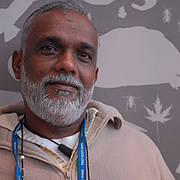Building biodiversity in crisis situations
11 October 2008 | News story
Rebuilding a country environmentally and socially after civil war and natural disasters is not easy. But that’s what chairman of the Sewalanka Foundation, Harsha Kumara Navaratne, does using IUCN and other partnerships in Sri Lanka.
“We link the technical assistance of IUCN with our community relationships, helping locals rebuild the environment after natural disasters such as the recent tsunami so biodiversity can return,” he said.
The Sewalanka Foundation helps rural communities to democratically identify and address their own development needs.
“We work with all aspects of the community, from fisherman and tea pickers to displaced people and the government, to set up discussions and build management plans,” says Harsha Kumara Navaratne.
Over the past 10 years, this IUCN member has become nationally and internationally recognized for its work in the field of development. It has developed a strategy that takes communities from conflict situations to a long-term programme of sustainable development.
The Sewalanka Foundation team comprises professional men and women – Sinhala and Tamil, Buddhist, Hindu, Muslim, and Christian – responsible for everything, from thinking of projects to implementing them at village level.
Harsha Kumara Navaratne says that working in some of the most disadvantaged communities presents new challenges on a daily basis, but the rewards are immense. “Talking about future goals and opportunities is inspiring, but reaching them is never an easy process,” he says.
“In some areas, we have seen strong community organizations pushed backwards, away from their goals, due to forces, like natural disaster and military movements, entirely out of their control. But we have also seen these same groups pick themselves up, reassess and move forward again. This vision of a better tomorrow has a powerful pull and talking about it keeps us focused and moving.”





